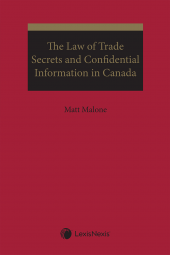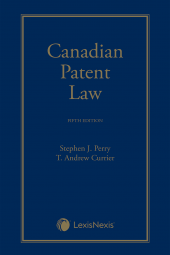The Law of Trade Secrets and Confidential Information in Canada
One Year Subscription Only Terms
Subscribers receive the product(s) listed on the Order Form and any Updates made available during the annual subscription period. Shipping and handling fees are not included in the annual price.
Subscribers are advised of the number of Updates that were made to the particular publication the prior year. The number of Updates may vary due to developments in the law and other publishing issues, but subscribers may use this as a rough estimate of future shipments. Subscribers may call Customer Support at 800-833-9844 for additional information.
Subscribers may cancel this subscription by: calling Customer Support at 800-833-9844; emailing customer.support@lexisnexis.com; or returning the invoice marked 'CANCEL'.
If subscribers cancel within 30 days after the product is ordered or received and return the product at their expense, then they will receive a full credit of the price for the annual subscription.
If subscribers cancel between 31 and 60 days after the invoice date and return the product at their expense, then they will receive a 5/6th credit of the price for the annual subscription. No credit will be given for cancellations more than 60 days after the invoice date. To receive any credit, subscriber must return all product(s) shipped during the year at their expense within the applicable cancellation period listed above.
Détails des produits
Today, trade secrets and confidential commercial information pertain to some of the most important assets in the digital and knowledge economies. Trade secrets are information-based assets that are not widely known, derive value from not being widely known, and have been the subject of reasonable steps to maintain and continue their secrecy. Confidential information are information-based assets that are not available from other sources in the public domain or obtainable by observation, independent study, or reverse engineering; originate in circumstances giving rise to a reasonable expectation the information will not be disclosed; and, whether supplied by law or voluntarily, are communicated within a relationship that will be fostered for the public benefit by confidential communication. Although confidential information does not always have economic value, assets of economic value are the focus of this work.
In this timely overview of the law, The Law of Trade Secrets and Confidential Information in Canada examines the Canadian law on trade secrets and confidential information in all its relevant domestic contexts. This includes the unique approaches of both the common law and Quebec civil law, relevant procedural considerations, criminal and national security dimensions of the law, and access to information frameworks. Additionally, it provides brief commentary on the history, justification, and policy objectives of the law. The work also provides an overview of proposed reforms.
Who Should Read This Book
Written in an accessible and fact-driven style, The Law of Trade Secrets and Confidential Information in Canada is designed and intended to serve as a reference and navigation tool for various readers, including:
- Holders of trade secrets and confidential information seeking guidance in the development, management, and protection of those assets
- Practitioners working in-house and at private firms in need of a practical, modern, and updated treatise to inform their work
- Government actors increasingly driven to respond to the new importance of trade secrets and confidential information
- Law faculties and schools where teachers, students, and staff are giving the subject renewed attention
Table des matières
Chapter 1: Introduction to the Law of Trade Secrets and Confidential Information Law
Chapter 2: Defining Trade Secrets and Confidential Information
Chapter 3: Normative and Descriptive Accounts
Chapter 4: Jurisdiction
Chapter 5: Civil Law (Common Law)
Chapter 6: Civil Law (Quebec)
Chapter 7: Confidentiality in Civil Proceedings
Chapter 8: Criminal Law and National Security Law
Chapter 9: Access To Information
Chapter 10: Proposed Reforms
 Lexis Nexis
Lexis Nexis 


